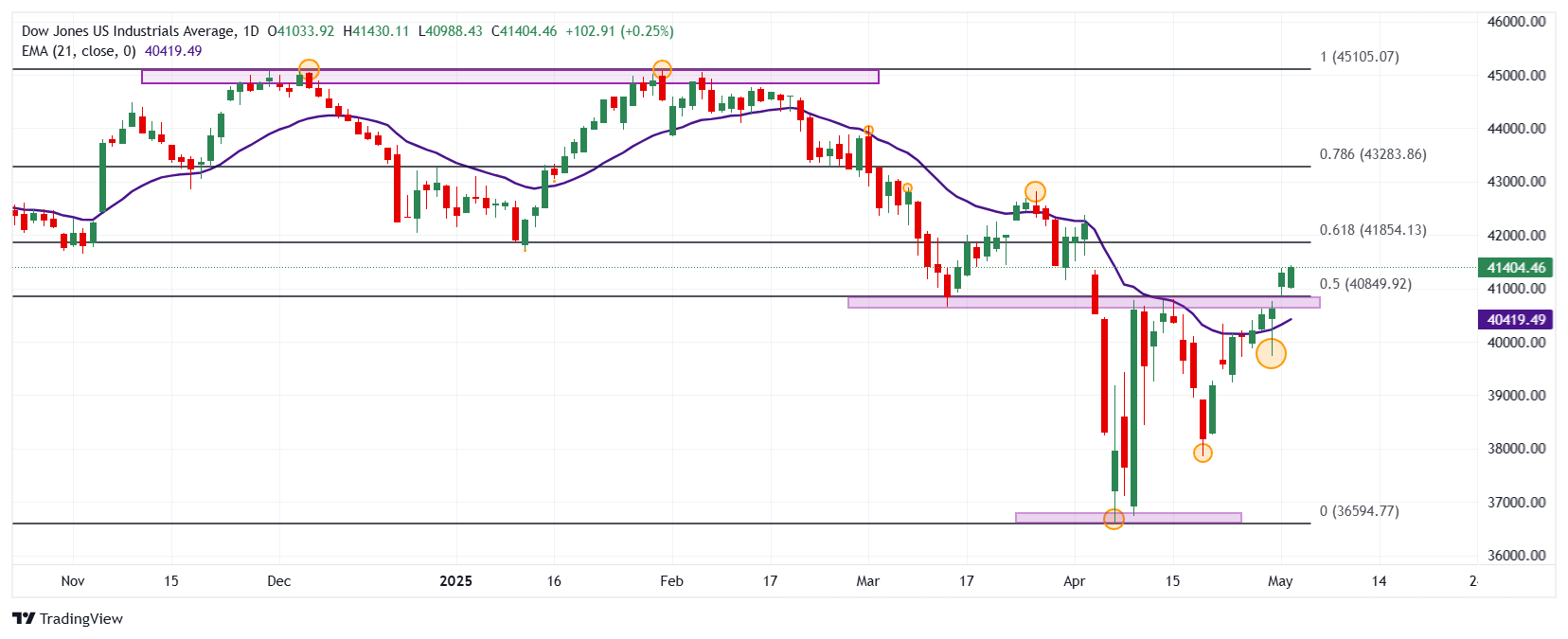- The Dow Jones rises 0.26% daily, exceeding maximums not seen since April 3 in 41,430.
- The Nasdaq 100 goes back 0.25% today, dragged by on semiconductor (ON).
- The S&P 500 falls 0.18% in the day, weighed by Zimmer Biomet Holdings (ZBH).
- The ISM services PMI exceeds analysts’ estimates when located at 51.6 points in April.
The Dow Jones marked a minimum of the day in 40,988, attracting aggressive buyers that promoted the index to a daily maximum in 4,1370.
The Dow Jones industrial average opened in 41,033, while the Nasdaq 100 technological index began operating at 20,076. The S&P 500 initiated the negotiations in 5,662, remaining within the operational range of the previous session.
UnitedHealth and McDonalds keep Dow Jones on positive terrain
The Dow Jones index wins 0.26% on the first day of the week, currently operating over 41,395.
The McDonalds Corporation (MCD) shares have a gain of 1.60% today, reaching maximum of May 1 in 317.46 $, ending with two consecutive days down.
Following the upward perspective, the titles of Unitedhealth (UNH) rise 2.25% daily, reaching 2 days in $ 409.16, leading the profits in the Dow Jones.
In this context, Dow Jones advances 106 points, signing its ninth consecutive day up and reaching maximums not seen since April 3 in 41,430.
The Nasdaq 100 is quoted down dragged by on semiconductor
The Nasdaq 100 technological index falls 0.21% on the first day of the week, consolidating within Friday’s operational range at 20,045.
The semiconductor (ON) values collapse 8.38% today, reaching a minimum of April 30 at $ 37,64 after the publication of its profits.
On obtained income for 1.45 billion dollars compared to the 1.4 projected by the market, as well as an action of 0.55 $ compared to the 0.52 estimated by analysts. Despite exceeding the forecasts, the results did not convince investors, punishing the price of the action.
On the other hand, the Microstrategy Incorporated (MSTR) titles lose 3.64% daily, visiting April 30 at 374.20 $, ending with two consecutive sessions upwards.
The Nasdaq 100 loses 45 points in the middle of a day with little volume due to the decision of interest rates by the Federal Reserve to be released on Wednesday.
The S&P 500 quotes down after the publication of the US PMI.
Based on information presented by the Institute of Offer Administration (ISM), the PMI of Services increased to 51.6 points in April, located above the 50.6 planned and 50.8 observed in March.
The S&P 500 goes back 14 points in the day, losing 0.25% and ending with a streak of eight consecutive days upward, consolidating within the range of Friday’s session at 5,668. In this sense, the shares of Zimmer Biomet Holdings (ZBH) collapse 9.48% after the publication of its quarterly report.
ZBH obtained revenues of 1.91 billion dollars compared to the 1.9 billion expected dollars and a gain per share of $ 1.81 compared to the 1,771 planned by the market. ZBH all marginally in the analysts’ forecasts, however, has not convinced investors who have punished the price of the action taking it to minimal not seen since April 3, 2020 in 90.51 $.
The focus of the operators will be placed on the decision of interest rates by the Federal Reserve to be released on Wednesday, May 7. Analysts expect it to remain unchanged by 4.5%.
Technical Analysis of Dow Jones
The Dow Jones reacted upwards from a short -term support given by the minimum of April 21 in 37,853. The following important support is observed in 36,614, minimum of April 7. Upwards, the key resistance is observed at 45,068, pivot point of January 31.
Dow Jones daily graphics

Dow Jones Faqs
The Dow Jones Industrial Avenge, one of the oldest stock market indexes in the world, consists of the 30 most negotiated values in the United States. The index is weighted by the price instead of capitalization. It is calculated by adding the prices of the values that compose it and dividing them by a factor, currently 0.152. The index was founded by Charles Dow, also founder of the Wall Street Journal. In recent years it has been criticized for not being sufficiently representative, since it only follows 30 companies, unlike broader rates such as S&P 500.
There are many factors that promote the Dow Jones Industrial Average (DJIA) index. The main one is the added performance of the companies that compose it, revealed in the quarterly reports of business benefits. The American and world macroeconomic data also contribute, since they influence investor confidence. The level of interest rates, set by the Federal Reserve (FED), also influences the DJia, since it affects the cost of credit, on which many companies depend largely. Therefore, inflation can be a determining factor, as well as other parameters that influence the decisions of the Federal Reserve.
Dow’s theory is a method to identify the main trend of the stock market developed by Charles Dow. A key step is to compare the direction of the Dow Jones Industrial Avenge (DJIA) and the Dow Jones Transportation Average (DJTA) and just follow the trends in which both move in the same direction. The volume is a confirmation criterion. The theory uses elements of maximum and minimum analysis. Dow’s theory raises three phases of the trend: accumulation, when intelligent money begins to buy or sell; Public participation, when the general public joins the trend; and distribution, when intelligent money abandons the trend.
There are several ways to operate with the DJ. One of them is to use ETF that allow investors to negotiate the DJ as a single value, instead of having to buy shares of the 30 companies that compose it. An outstanding example is the SPDR Dow Jones Industrial Avenge ETF (day). Future contracts on the DJ allow the specular operators about the future value of the index and the options provide the right, but not the obligation, to buy or sell the index at a predetermined price in the future. Investment funds allow investors to buy a part of a diversified portfolio of DJ values, which provides exposure to global index.
Source: Fx Street
I am Joshua Winder, a senior-level journalist and editor at World Stock Market. I specialize in covering news related to the stock market and economic trends. With more than 8 years of experience in this field, I have become an expert in financial reporting.







